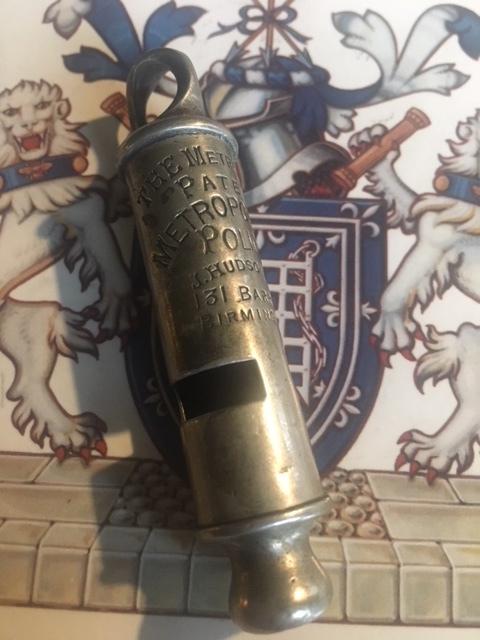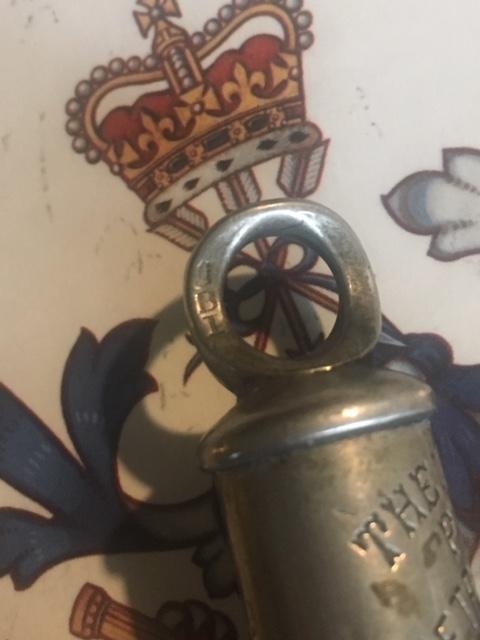-
Posts
297 -
Joined
-
Last visited
-
Days Won
1
Content Type
Profiles
Forums
Blogs
Gallery
Events
Store
Everything posted by Mike McLellan
-
Gentlemen, after much reflection and inner turmoil, I must admit that my original hypothesis was totally without merit. It is, indeed, a 1911 coronation medal. The photographer’s flash was of such a brilliance that the chemical composition of the blue stripes on the medal ribbon flouresced brightly and this bright reflection of light was captured on the photographers plate, reacting with the silver nitrate. The red portion of the ribbon, being of a somewhat different chemical makeup, did not reflect the light of the flash to any significant degree, so the red portion appears grey, as it should, while the blue stripes appear white, as in a burst of light. Examining different studio photos of policemen with their medals, one can see this same phenominum occurring quite frequently, especially with the 1902 medals, which appear grey with a single white stripe down the middle. In this particular case, the camera is not focused very sharply, and the slight blurriness exascerbates the allusion, making the blue stripes appear wider than they really are. Sorry to start this argument in the first place, but I’m old and it gets a little lonely out on the tundra, and I like to hear myself talk. I feel much better now. Thank you. Mike
-
Hello David. Truncheon collecting is a very dangerous mine-field. Step cautiously. It’s difficult to confirm if ANY truncheon is: old, authentic, police related, re-painted, home-made, etc. If it were me, I think I’d wait until an example that I could more easily identify surfaces. I could be wrong, but I’d say that there is no way on Earth that this particular stick can be attributable to any force. Just my opinion. Mike Hah. David beat me to the enter key!
-
Thank you Simon. I neglected to cite another extremely useful source of information for the whistle collectors out there. "The Whistle Museum" by Avner Strauss contains a wealth of information and loads of quality illustrations. Between the 3 sources of information that I used, and is, for the most part on-line, anybody that has an older police whistle can zero in on the date of manufacture or other info. Fascinating stuff. I had no idea that the real experts knew that much!! Anyway: Another old timer. This, according to Gilchrist's work is known as the MP3, (i.e.. the third issue Met whistle) from 1885. The difference from the MP1 that is shown above, is in the address, the inclusion of the word 'Patent', and the stamp on the ring, which defines it as a 'certified' police whistle! There are a few more whistles around here; mostly on key rings scattered around the house. If I find one that's note-worthy, I'll post a picture or two. In the meantime, I'd like to see some other examples from the collectors of GMIC. Maybe someone can shed some light on the serial numbers. I can't seem to find any cross-reference to establish any kind of date of manufacture or shipping, etc.
-
Breathtaking! Beautiful!
-
Disclaimer: I'm not a whistle collector, although I do have a few that are part of my collection of Metropolitan Police insignia and memorabilia. Nor am I an expert. All of my knowledge on the subject of police whistles came to me, over the past 35 years, from the real experts like Martyn Gilchrist. Lief Bailey, and others. Luckily, for all of us, their knowledge is still readily available to us through their research and writings, and all of it just a click away via the internet. Having said that, I'd like to resuscitate this wonderful thread with a few words about a couple of old whistles in my collection. The first one is an oldie: a General Service Whistle by Hudson's of Birmingham showing his address at 84 Buckingham Street. After being awarded the contract to supply the Metropolitan Police with his new whistle, he was able to move his manufactory to a more suitable location on Carr Street that same year, 1884. The serial number of 6751 places it among the first batch of whistles, referred to by collectors as "MP1", commissioned by the Metropolitan Police in 1884. It's attached to a chain, that I'm not able to date, but it's paired with a call box key. The call boxes were distributed around the Metropolis in 1929. I'm not sure when they were decommissioned, but I've read somewhere that the same key provides access to certain traffic-control devices throughout the city. The switch from ratchet rattles to whistles as calls for assistance or raising the 'Hue and Cry' did not come as an epiphany to the Metropolitan Police. The wooden rattle was hopelessly inadequate when competing with the deafening noise of the city, and although whistles had been in use by the military and police, in one form or another since the 1850's, the whistle of the day, the so-called Beaufort Whistle had a rather anemic sound, and while it might be suitable for some purposes, it was not loud enough for emergency attention getting. I have one of the old whistles that dates from the 1850's or 1860's from none other than the firm of Parker, Field, & Son of 233 Holborn, London. As they were the principal armorers for The Metropolitan Police at the time, I suspect that their whistles were used in some capacity by that force.
-

Korean Empire officials obtained order and medal
Mike McLellan replied to 1812 Overture's topic in South East & East Asia
Amazing pictures! Begs an argument for reunification as well as against. Great photos. Thanks for sharing. Mike -
At the risk of being totally off base (a risk I take almost every time I venture an opinion), I believe the armband you have is for one of the county forces. The Met regular police as well as the Met S.C wore the band but neither wore the attached Brassard. The various Commanders of Special Constabularies across the country had a bit of flexability in terms of uniform hardware. Some chose numbered Brassards at some cost, as well as badges. Some were more conservative. There is a very fine thread on Special Constable regalia started by Brian that is filled with examples of S.C. Insignia. Mike
-

Book Wanted
Mike McLellan replied to David68's topic in Great Britain: Mervyn Mitton's British & Colonial Police Forces
Ebay.co.uk has a couple of choices at the moment, including a curious lot comprised of 100 copies of the book. Mike -
For the collector with any interest in Special Constabulary insignia and equipment, this thread is a must read. To say that the contributors provide a wealth of information would be an understatement. I just finished reading it, (all 34 pages) for the second time. The first time, I was looking for a particular badge. This time, I was trying to discover when the Metropolitan Police and the Metropolitan Special Constabulary wore the vertical stripes armband AND when both entities wore the armlet with horizontal stripes. Did they wear them alike at the same time or were the changes at different times? Which is the earlier version? when did both forces move the armlet up or down on their sleeve? As always, I would be grateful for any shared wisdom from the gentlemen of this forum. Thanks, Mike.
-
Great job with the tunic. Stories like the ones outlining the provenance generally don’t appear out of thin air. An element of truth is quite often woven into the fabric of the tale. I’m trying, though, to reconstruct the scenario whereby the constable rides (or runs) off without his trousers. Sounds like a job for CID.
-

EK1 with Spange. Opinions please?
Mike McLellan replied to bigal2rf's topic in Germany: All Eras: The Iron Cross
Man, that didn’t go very well! First of all bigal, welcome to the forum. Despite the sometimes brutal honesty, this is just about the friendliest forum on the web for collectors. There are many, many posts that will help you in choosing which things to buy, and which things to be leery of. I’ve read somewhere on this site that a one piece item such as yours is a dead give-away. There are other things as well to watch out for. In time, you’ll gain quite an education around this place, even if it’s by accident. At any rate, don’t be put off by one questionable purchase. Every person on this site has made them. The trick is not letting them get you down. Again, welcome aboard! Mike. -
I could never afford to be a collector of early police truncheons, but, over the years, a few have slipped, unnoticed, into my collection of old cop-related things. I do have an avid novice's interest in them, and when a particularly beautiful example surfaces on one of the dealer or auction sites, I study the photos and attempt to glean as much information as I can about them. Depictions of the Royal Coat of Arms in all of its variant forms are of particular interest to me, and the subtleties and nuanced differences in the artistry are fascinating. In some examples, the artist's talent is breathtaking. In others, less so. But in general, artists always adhere to the official Blazon of the arms which mandates the appropriate colors. For example: In the royal COA, the first and fourth quarter are red (gules) with 3 lions. The third quarter is blue (azure) with the Irish harp. At this very moment, on the saleroom site, there are two truncheons, offered by different auction houses, where the first and fourth quarters of the royal arms is blue with three lions, and the Irish harps quarter has a red background! The exclamation mark is a feeble attempt to make my observations less boring. But why would an otherwise beautifully done depiction of the COA have the wrong colors? One truncheon looks like it was created yesterday, It is in mint condition. There is a curious ball finial above the crown, but otherwise meets my non-expert expectations. The colors of the COA, though, just makes it look fake to me. I'm left with the impression that this stick was created by a highly skilled artisan on the sub continent, or further east. The other example is a baluster style truncheon that is beautifully crafted and painted with great skill. It has the appearance and condition one might expect of a GlllR stick. But it, too, has blue in the first and fourth quarter, and red in the third quarter. These are the only examples that I've noticed where the colors are patently incorrect. Am I making a big deal out of nothing? Are they honest mistakes of the artists or whoever commissioned their manufacture? Have I just been non-observant over the years, and missed numerous examples of what I've described? What do you think? Mike
-

Avatar Names; Why?
Mike McLellan commented on Brian Wolfe's blog entry in News From the Home Office.
My attorney told me to keep a low profile while we’re in litigation. Mike is my ex, so if he doesn’t like me using his name, so what. My real name is Stormy Daniels. -
Cheers David. What’s it like to live in the future? Being 9 hours behind GMT, I’m so far into the past, that by the time I roll out of the sack, everything’s over and everyone’s gone home! I’m a frequent visitor to Thesaleroom.com or something like that. If you check it often enough, I’m sure that you’ll find all the police medals and other cop related things that will drain your bank account as it has mine. There are other sites, but that one is purely an auction site. Good luck and let’s see some of the things you’ve collected so far. Mike
-
Mr. Spasm, I hope I don’t cause you any discomfort or embarrassment by saying this, but you’re a freaking genius. Even though you provide excellent notes and step-by-step instructions, you’ve raised the bar so high in your artistry and craftsmanship, that most of us can just stare in awe and disbelief. Despite the archival evidence that you so generously provide, your descendants will examine your various projects and wonder, “How in the Hell did he do that?”. Absolutely amazing!
-

Big miniature bar
Mike McLellan replied to Leuchtturm's topic in Great Britain: Orders, Gallantry, Campaign Medals
Fascinating ribbons. Surely, a DSO who: served in Egypt, South Africa, MID in the Great War, and still had enough energy to serve on the home front in the Second Great War, cannot remain anonymous for too long around here. Just wait. Someone will come up with name and probably a photo of your man.






